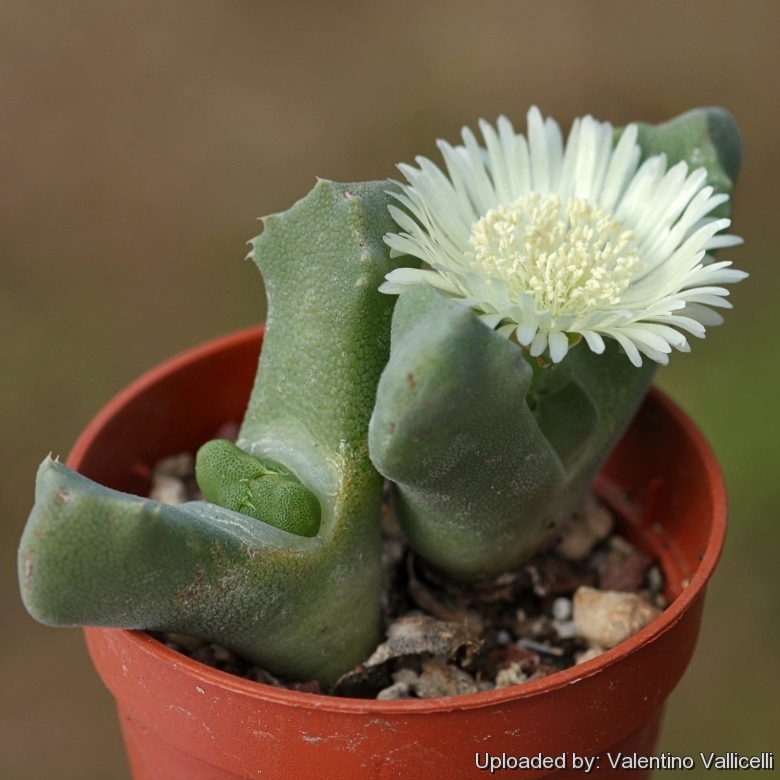
Odontophorus nanus Photo by: Valentino Vallicelli
Origin and Habitat: Little Namaqualand, western and Northern Cape, South Africa.
Habitat: It grows on white quartzite rocks and slopes.
Altitude: 850-1200 m.
Synonyms:
See all synonyms of Odontophorus nanus
back
Accepted name in llifle Database:Odontophorus nanus L. BolusNotes Mesembryanthemum [H.M.L. Bolus] 2: 59. 1929 [12 Apr 1929]Synonymy: 6
back
Common Names include:
AFRIKAANS (Afrikaans): Meerkatbekkie
Description: Odontophorus nanusSN|18097]]SN|18097]] is a dwarf, compact, clump-forming succulent with leaves very thick and soft. There is a great variation between populations in leaf sizes and surfaces as well as in flower colour.
Stems: Very short 1-2 cm long with 1-2 leaf-pairs.
Leaves: 25-50 mm long, 11-18 mm thick, thick, soft, 3-angled,very gibbous, upper surface rounded at tip, lower surface almost semicylindric, margins with (1-)4-5(-6) broad teeth, keel with 0-1 teeth, teeth on elevations of leaves brittle, epidermis very velvety appearing white from dense, hairy warts, hairs long, rarely smooth and shiny.
Flowers: Solitary, stalked, about 4,3 cm across, petals light yellowish-brown, often cream-coloured, some-times white; Sepals 5, the inner with membranous margins. Stamens erect. in 6 rows, papillose, staminodes absent. Ovary inferior with parietal placentas; nectary-glands toothed or scalloped. Stigmas 8-11, narrowly ovate. Stalk about 3 cm long.
Fruit: Shorter, capsules lower than in the other species, base with long hairs, bracteoles parchment-like.
Seed: Less than 0,9 mm long, disc-shaped, ovate, pale brown, testa smooth except for low papillae at hilum.
Bibliography: Major references and further lectures
1) Heidrun E. K. Hartmann “Aizoaceae F – Z” Springer, 2002
2) Hartmann. H. “Monographie der Gattung Odontophorus” Botantsche Jahrbucher 97: 161-225 (1976)
3) Jacobsen. “Handbook of succulent plants” 1328 (1960)
4) James Cullen, Sabina G. Knees, H. Suzanne Cubey “The European Garden Flora Flowering Plants: A Manual for the Identification of Plants Cultivated in Europe, Both Out-of-Doors and Under Glass - Casuarinaceae to Aristolochiaceae” Cambridge University Press, 11/ago/2011
5) Raimondo, D., von Staden, L., Foden, W., Victor, J.E., Helme, N.A., Turner, R.C., Kamundi, D.A. and Manyama, P.A. 2009. “Red List of South African Plants.” Strelitzia 25. South African National Biodiversity Institute, Pretoria.
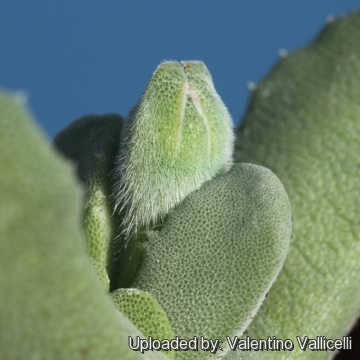 Odontophorus nanus Photo by: Valentino Vallicelli
Odontophorus nanus Photo by: Valentino Vallicelli Odontophorus nanus Photo by: Valentino Vallicelli
Odontophorus nanus Photo by: Valentino Vallicelli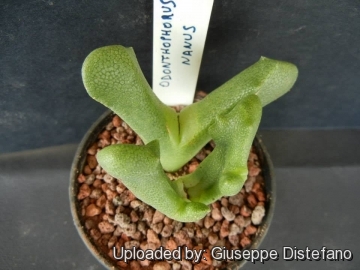 Odontophorus nanus Photo by: Giuseppe Distefano
Odontophorus nanus Photo by: Giuseppe Distefano Odontophorus nanus Photo by: Valentino Vallicelli
Odontophorus nanus Photo by: Valentino Vallicelli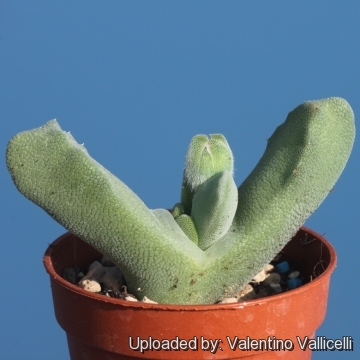 Odontophorus nanus Photo by: Valentino Vallicelli
Odontophorus nanus Photo by: Valentino Vallicelli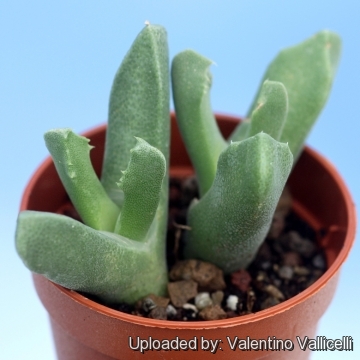 - Odontophorus nanus SB803 (Collector: Steven Brack) Eenrietberg, Steinkopf, Little Namaqualand, North-West Cape Province, South Africa Photo by: Valentino Vallicelli
- Odontophorus nanus SB803 (Collector: Steven Brack) Eenrietberg, Steinkopf, Little Namaqualand, North-West Cape Province, South Africa Photo by: Valentino VallicelliCultivation and Propagation: The Odontophorus are easy to grow. However Odontophorus nanusSN|18097]]SN|18097]] does not do as well in cultivation as most of the other Odontophorus. However if you provide the Odontophorus with the right conditions, they will reward you with their unique shape, size, colour and a proliferation of blooms.
Soil: It grows best in sandy-gritty soil. Good drainage is very important as it is prone to root rot. It can grows outdoor in sunny, dry, rock crevices (protection against winter wet is required) It can also be cultivated in alpine house, in poor, drained soil.
Fertilization: Feed it once during the growing season with a fertilizer specifically formulated for cacti and succulents (poor in nitrogen), including all micro nutrients and trace elements diluted to ½ the strength recommended on the label. It thrives in poor soils and need a limited supplies of fertilizer to avoid the plants developing excess vegetation, which is easily attacked by fungal diseases.
Watering: Regular water from spring through to autumn. Water minimally in winter, only when the plant starts shrivelling, but it will generally grow even in winter if given water, and let the soil dry between soaking. If grown in a container, bottom watering by immersing the container is recommended. It must have very dry atmosphere.
Light: It needs a bright sunny or light shade exposure in winter, but keep cool and shaded in summer.
Hardiness: It prefer a very bright situation and require a minimum temperature -5°C (or less if dry). USDA zones 9A – 11.
Uses: Container, rock garden.
Pests and diseases: It is vulnerable to mealybugs and rarely scale.
Propagation: Seed in spring or (or rarely) cuttings. To make a cutting twist off a rosette with at least a part of stem and permit it to dry out a couple of days, lay it on the soil and insert the stem end partially into the soil. Try to keep the cutting somewhat upright so that the roots are able to grow downward.
















